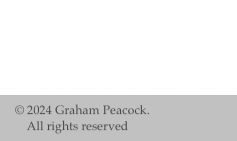|
Peacock works unusual
Bold use of colour innovative
Elizabeth Beauchamp,, The Edmonton Journal. November 19, 1988
Since acquiring her new gallery, art dealer Agnes Bugera -- also of the Bearclaw -- has slowly but steadily, (with the help of Terry Fenton, among others) attracted some fine artists to represent.
Presumably only hallway to the eventual goal of showcasing art which distinguishes itself with a relevance to the best of what's happening, the Gallery on Whyte still has the capacity to bore the unwary eye, but happily now it can also surprise, even astonish, with the unexpected.
The inventory runs the proverbial gamut. There's downright bad, there's dull but commercially viable and now, more and more, there's very good work gracing the walls and plinths, all displayed together in the flea market jumble of the little room. In the main exhibition space, there can usually be found a safe, but dull show - although that's also changing for the better.
It shouldn't come as a complete surprise, then, to find an exhibition of Graham Peacock's latest series called Rocaille (rock-like or rockery) in this setting. Although these small works are more approachable and accessible than his usual large canvases, everything about them is distinctly unusual.
The acrylic paint itself is the result of more than a decade of experimentation as a high water content with the capacity to produce the sought after shrinking and buckling was achieved.
Peacock's method of "painting" is also completely individual. The prepared paper is set in a wooden rack and allowed to take a concave shape. Collage material, usually acrylic skins saved from old paint tins and pieces of canvas, are randomly dropped on to the paper. The paint for the most part is then poured on to the papa forming a thick pool.
After the paint dries, more colors are poured, producing a relict of thick acrylic paint. The mixing that goes on between the colors on the paper and the formation of the irregular surface as the thick paint dries and shrinks around the collage elements arc often quite out of the artist's control.
But it is this process a the painting evolves, where artistic decisions and responses are made every step of the way, which actually furnishes the inspiration and makes the work unique.
To the random happenings on the paper, directly brushed paint is added to highlight, contour or sub-due the colors and textures, all in support of the central relief. An aura is then brushed around the image setting it off like a contemporary icon. The final buckling of the paper is even directed by the artist in mounting the painting on to a card slightly smaller than the actual work.
The most innovative element in these works, perhaps even more than the surface texture, is the bold use of color pushed to the limit. There's high- voltage blasts that vibrate against one another and etch their way on to the eyeball, a visual equivalent of our high-powered modern culture.
These works are now! They clamor for attention, push their way into our sight and refuse to be set aside.
Don't miss the fine and delicate topographical landscape watercolors in the small room, also by Graham Peacock.
|
|
|



